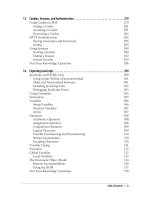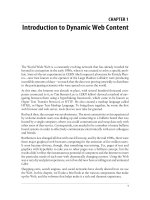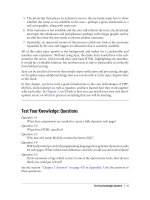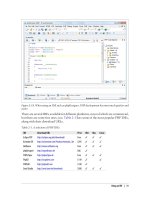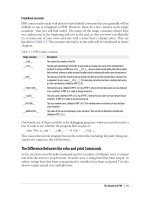Học php, mysql và javascript - p 11 pps
Bạn đang xem bản rút gọn của tài liệu. Xem và tải ngay bản đầy đủ của tài liệu tại đây (1.43 MB, 10 trang )
Example 4-31 shows a modified version of the multiplication table for 12 code using
such a loop.
Example 4-31. A do while loop for printing the times table for 12
<?php
$count = 1;
do
echo "$count times 12 is " . $count * 12 . "<br />";
while (++$count <= 12);
?>
Notice how we are back to initializing $count to 1 (rather than 0), because the code is
being executed immediately, without an opportunity to increment the variable. Other
than that, though, the code looks pretty similar.
Of course, if you have more than a single statement inside a do while loop, remember
to use curly braces, as in Example 4-32.
Example 4-32. Expanding Example 4-31 to use curly braces
<?php
$count = 1;
do {
echo "$count times 12 is " . $count * 12;
echo "<br />";
} while (++$count <= 12);
?>
for Loops
The final kind of loop statement, the for loop, is also the most powerful, as it combines
the abilities to set up variables as you enter the loop, test for conditions while iterating
loops, and modify variables after each iteration.
Example 4-33 shows how you could write the multiplication table program with a
for loop.
Example 4-33. Outputting the times table for 12 from a for loop
<?php
for ($count = 1 ; $count <= 12 ; ++$count)
echo "$count times 12 is " . $count * 12 . "<br />";
?>
See how the entire code has been reduced to a single for statement containing a single
conditional statement? Here’s what is going on. Each for statement takes three
parameters:
• An initialization expression
• A condition expression
Looping | 81
• A modification expression
These are separated by semicolons like this: for (expr1 ; expr2 ; expr3). At the start
of the first iteration of the loop, the initialization expression is executed. In the case of
the times table code, $count is initialized to the value 1. Then, each time round the loop,
the condition expression (in this case, $count <= 12) is tested, and the loop is entered
only if the condition is TRUE. Finally, at the end of each iteration, the modification
expression is executed. In the case of the times table code, the variable $count is
incremented.
All this structure neatly removes any requirement to place the controls for a loop within
its body, freeing it up just for the statements you want the loop to perform.
Remember to use curly braces with a for loop if it will contain more than one statement,
as in Example 4-34.
Example 4-34. The for loop from Example 4-33 with added curly braces
<?php
for ($count = 1 ; $count <= 12 ; ++$count)
{
echo "$count times 12 is " . $count * 12;
echo "<br />";
}
?>
Let’s compare when to use for and while loops. The for loop is explicitly designed
around a single value that changes on a regular basis. Usually you have a value that
increments, as when you are passed a list of user choices and want to process each
choice in turn. But you can transform the variable any way you like. A more complex
form of the for statement even lets you perform multiple operations in each of the three
parameters:
for ($i = 1, $j = 1 ; $i + $j < 10 ; $i++ , $j++)
{
//
}
That’s complicated and not recommended for first-time users. The key is to distinguish
commas from semicolons. The three parameters must be separated by semicolons.
Within each parameter, multiple statements can be separated by commas. Thus, in the
previous example, the first and third parameters each contain two statements:
$i = 1, $j = 1 // Initialize $i and $j
$i + $j < 1 // Terminating condition
$i++ , $j++ // Modify $i and $j at the end of each iteration
The main thing to take from this example is that you must separate the three parameter
sections with semicolons, not commas (which should be used only to separate state-
ments within a parameter section).
82 | Chapter 4: Expressions and Control Flow in PHP
So, when is a while statement more appropriate than a for statement? When your
condition doesn’t depend on a simple, regular change to a variable. For instance, if you
want to check for some special input or error and end the loop when it occurs, use a
while statement.
Breaking Out of a Loop
Just as you saw how to break out of a switch statement, you can also break out from a
for loop using the same break command. This step can be necessary when, for example,
one of your statements returns an error and the loop cannot continue executing safely.
One case in which this might occur might be when writing a file returns an error,
possibly because the disk is full (see Example 4-35).
Example 4-35. Writing a file using a for loop with error trapping
<?php
$fp = fopen("text.txt", 'wb');
for ($j = 0 ; $j < 100 ; ++$j)
{
$written = fwrite($fp, "data");
if ($written == FALSE) break;
}
fclose($fp);
?>
This is the most complicated piece of code that you have seen so far, but you’re ready
for it. We’ll look into the file handling commands in a later chapter, but for now all
you need to know is that the first line opens the file text.txt for writing in binary mode,
and then returns a pointer to the file in the variable $fp, which is used later to refer to
the open file.
The loop then iterates 100 times (from 0 to 99) writing the string data to the file. After
each write, the variable $written is assigned a value by the fwrite function representing
the number of characters correctly written. But if there is an error, the fwrite function
assigns the value FALSE.
The behavior of fwrite makes it easy for the code to check the variable $written to see
whether it is set to FALSE and, if so, to break out of the loop to the following statement
closing the file.
If you are looking to improve the code, the line:
if ($written == FALSE) break;
can be simplified using the NOT operator, like this:
if (!$written) break;
Looping | 83
In fact, the pair of inner loop statements can be shortened to the following single
statement:
if (!fwrite($fp, "data")) break;
The break command is even more powerful than you might think, because if you have
code nested more than one layer deep that you need to break out of, you can follow
the break command with a number to indicate how many levels to break out of, like this:
break 2;
The continue Statement
The continue statement is a little like a break statement, except that it instructs PHP to
stop processing the current loop and to move right to its next iteration. So, instead of
breaking out of the whole loop, only the current iteration is exited.
This approach can be useful in cases where you know there is no point continuing
execution within the current loop and you want to save processor cycles, or prevent an
error from occurring, by moving right along to the next iteration of the loop. In Ex-
ample 4-36, a continue statement is used to prevent a division-by-zero error from being
issued when the variable $j has a value of 0.
Example 4-36. Trapping division-by-zero errors using continue
<?php
$j = 10;
while ($j > −10)
{
$j ;
if ($j == 0) continue;
echo (10 / $j) . "<br />";
}
>
For all values of $j between 10 and −10, with the exception of 0, the result of calculating
10 divided by $j is displayed. But for the particular case of $j being 0, the continue
statement is issued and execution skips immediately to the next iteration of the loop.
Implicit and Explicit Casting
PHP is a loosely typed language that allows you to declare a variable and its type simply
by using it. It also automatically converts values from one type to another whenever
required. This is called implicit casting.
However, there may be times when PHP’s implicit casting is not what you want. In
Example 4-37, note that the inputs to the division are integers. By default, PHP converts
the output to floating-point so it can give the most precise value—4.66 recurring.
84 | Chapter 4: Expressions and Control Flow in PHP
Example 4-37. This expression returns a floating-point number
<?php
$a = 56;
$b = 12;
$c = $a / $b;
echo $c;
?>
But
what if we had wanted $c to be an integer instead? There are various ways in which
this could be achieved; one way is to force the result of $a/$b to be cast to an integer
value using the integer cast type (int), like this:
$c = (int) ($a / $b);
This is called explicit casting. Note that in order to ensure that the value of the entire
expression is cast to an integer, the expression is placed within parentheses. Otherwise,
only the variable $a would have been cast to an integer—a pointless exercise, as the
division by $b would still have returned a floating-point number.
You can explicitly cast to the types shown in Table 4-6,
but you can
usually avoid having to use a cast by calling one of PHP’s built-in func-
tions. For example, to obtain an integer value, you could use the
intval function. As with some other sections in this book, this one is
mainly here to help you understand third-party code that you may
encounter.
Table 4-6. PHP’s cast types
Cast type Description
(int) (integer) Cast to an integer by dropping the decimal portion
(bool) (boolean) Cast to a Boolean
(float) (double) (real) Cast to a floating-point number
(string) Cast to a string
(array) Cast to an array
(object) Cast to an object
PHP Dynamic Linking
Because PHP is
a programming language, and the output from it can be completely
different for each user, it’s possible for an entire website to run from a single PHP web
page. Each time the user clicks on something, the details can be sent back to the same
web page, which decides what to do next according to the various cookies and/or other
session details it may have stored.
PHP Dynamic Linking | 85
But although it is possible to build an entire website this way, it’s not recommended,
because your source code will grow and grow and start to become unwieldy, as it has
to take account of every possible action a user could take.
Instead, it’s much more sensible to split your website development into different parts.
For example, one distinct process is signing up for a website, along with all the checking
this entails to validate an email address, checking whether a username is already taken,
and so on.
A second module might well be one for logging users in before handing them off to the
main part of your website. Then you might have a messaging module with the facility
for users to leave comments, a module containing links and useful information, another
to allow uploading of images, and so on.
As long as you have created a means of tracking your user through your website by
means of cookies or session variables (both of which we’ll look at more closely in later
chapters), you can split your website up into sensible sections of PHP code, each one
self-contained, and therefore treat yourself to a much easier future developing each new
feature and maintaining old ones.
Dynamic Linking in Action
One of the more popular PHP-driven applications on the web today is the blogging
platform WordPress (see Figure 4-5). As a blogger or a blog reader, you might not realize
it, but every major section has been given its own main PHP file, and a whole raft of
generic, shared functions have been placed in separate files that are included by the
main PHP pages as necessary.
Figure 4-5. The WordPress blogging platform is written in PHP
86 | Chapter 4: Expressions and Control Flow in PHP
The whole platform is held together with behind-the-scenes session tracking, so that
you hardly know when you are transitioning from one subsection to another. So, as a
web developer, if you want to tweak WordPress, it’s easy to find the particular file you
need, make a modification, and test and debug it without messing around with un-
connected parts of the program.
Next time you use WordPress, keep an eye on your browser’s address bar, particularly
if you are managing a blog, and you’ll notice some of the different PHP files that it uses.
This chapter has covered quite a lot of ground, and by now you should be able to put
together your own small PHP programs. But before you do, and before proceeding with
the following chapter on functions and objects, you may wish to test your new knowl-
edge on the following questions.
Test Your Knowledge: Questions
Question 4-1
What actual underlying values are represented by TRUE and FALSE?
Question 4-2
What are the simplest two forms of expressions?
Question 4-3
What is the difference between unary, binary, and ternary operators?
Question 4-4
What is the best way to force your own operator precedence?
Question 4-5
What is meant by “operator associativity”?
Question 4-6
When would you use the === (identity) operator?
Question 4-7
Name the three conditional statement types.
Question 4-8
What command can you use to skip the current iteration of a loop and move on
to the next one?
Question 4-9
Why is a for loop more powerful than a while loop?
Question 4-10
How do if and while statements interpret conditional expressions of different data
types?
See the section “Chapter 4 Answers” on page 438 in Appendix A for the answers to
these questions.
Test Your Knowledge: Questions | 87
CHAPTER 5
PHP Functions and Objects
The basic requirements of any programming language include somewhere to store data,
a means of directing program flow, and a few bits and pieces such as expression eval-
uation, file management, and text output. PHP has all these, plus tools like else and
elseif to make life easier. But even with all these in our toolkit, programming can be
clumsy and tedious, especially if you have to rewrite portions of very similar code each
time you need them.
That’s where functions and objects come in. As you might guess, a function is a set of
statements that performs a particular function and—optionally—returns a value. You
can pull out a section of code that you have used more than once, place it into a function,
and call the function by name when you want the code.
Functions have many advantages over contiguous, inline code:
• Less typing is involved.
• Functions reduce syntax and other programming errors.
• They decrease the loading time of program files.
• They also decrease execution time, because each function is compiled only once,
no matter how often you call it.
• Functions accept arguments and can therefore be used for general as well as specific
cases.
Objects take this concept a step further. An object incorporates one or more functions,
and the data they use, into a single structure called a class.
In this chapter, you’ll learn all about using functions, from defining and calling them
to passing arguments back and forth. With that knowledge under your belt, you’ll start
creating functions and using them in your own objects (where they will be referred to
as methods).
89
PHP Functions
PHP comes with hundreds of ready-made, built-in functions, making it a very rich
language. To use a function, call it by name. For example, you can see the print function
in action here:
print("print is a function");
The parentheses tell PHP that you’re referring to a function. Otherwise, it thinks you’re
referring to a constant. You may see a warning such as this:
Notice: Use of undefined constant fname - assumed 'fname'
followed by the text string fname, under the assumption that you must have wanted to
put a literal string in your code. (Things are even more confusing if there is actually a
constant named fname, in which case PHP uses its value.)
Strictly speaking, print is a
pseudofunction, commonly called a con-
struct. The difference is that you can omit the parentheses, as follows:
print "print doesn't require parentheses";
You do have to put parentheses after any other function you call, even
if they’re empty (that is, if you’re not passing any argument to the
function).
Functions can take any number of arguments, including zero. For example, phpinfo,
as shown here, displays lots of information about the current installation of PHP and
requires no argument. The result of calling this function can be seen in Figure 5-1.
phpinfo();
The phpinfo function is
extremely useful for obtaining information
about your current PHP installation, but that information could also be
very useful to potential hackers. Therefore, never leave a call to this
function in any web-ready code.
Some of the built-in functions that use one or more arguments appear in Example 5-1.
Example 5-1. Three string functions
<?php
echo strrev(" .dlrow olleH"); // Reverse string
echo str_repeat("Hip ", 2); // Repeat string
echo strtoupper("hooray!"); // String to uppercase
?>
This example uses three string functions to output the following text:
Hello world. Hip Hip HOORAY!
90 | Chapter 5: PHP Functions and Objects

